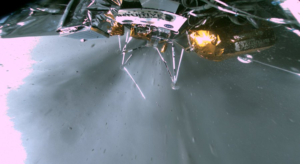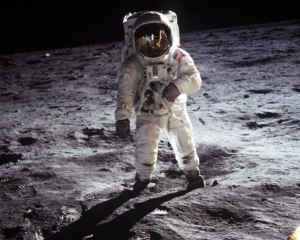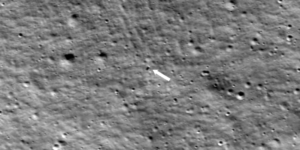
A Private U.S. Company Just Landed On The Moon!
After a successful launch and week-long journey, a private company has managed to land on the Moon. This marks the first U.S. Moon landing in over half a century with the last one taking place in 1972. Despite a communication issue that occurred during the landing, the company responsible, Intuitive Machines, has reported that the uncrewed lander is upright and both sending and receiving data.
With this part of its journey out of the way, it now plans to begin conducting a long list of science and experiments on the surface. However, the lander is not designed to survive the cold lunar night which puts some time pressure on its operations. Here I will go more in-depth into the vehicle’s landing, journey from Earth, its busy next few days, and more.
Successful Landing

Starting a week ago on the 15th, a Falcon 9 launched the lander named Odysseus and began its trip to the Moon. About 6 days later on the 21st, it had achieved lunar orbit. At that point, it began preparing for the upcoming landing. On the 22nd by 5:00 pm EST, it was orbiting the Moon, approximately 12 miles above the lunar surface. At that point in time it was expected to land at 6:24 p.m. EST near Malapert A in the south polar region of the Moon. Around that time Intuitive Machines updated the landing schedule. In a quote they said, “Flight controllers analyzed the post-Lunar Orbit Insertion engine burn data and updated the anticipated flight maneuver timing, including an expected 1630 CST landing opportunity on Thursday. In other words, they moved up the landing by around an hour. This would change a few more time before the actual landing.
One reason had to do with an error that was discovered related to the lander’s laser rangefinders, which allow it to determine its altitude and horizontal velocity. As a fix, controllers uploaded a software patch to enable the lander to instead use a NASA Doppler lidar payload originally intended to be a technology demonstration. A NASA deputy associate administrator for space technology said, “Basically, it is the primary system to help provide the velocity and altitude information.”
Watching the live broadcast, with this fix in place, the lander made its way down to the surface as the clock counted down toward touchdown. Odysseus fired up its main engine for an 11-minute burn that slowed the craft’s descent toward the lunar surface. This was the final primary action before the landing. However, as the clock hit zero, it was unknown the state of the lander and whether or not it had successfully completed this part of the mission. It took a tense 15 minutes before the team acquired the lander’s signal and confirmed it was still operating. “What we can confirm without a doubt is, our equipment is on the surface of the moon and we are transmitting,” mission director Tim Crain said after that milestone moment. “Odysseus has found his new home” they said.
Soon after the touchdown the company tweeted saying, “After troubleshooting communications, flight controllers have confirmed Odysseus is upright and starting to send data. Right now, we are working to downlink the first images from the lunar surface.” The specific crater area they chose to land in is just 300 km from the lunar South Pole and was chosen due to the fact that it appeared to be a relatively flat and safe place on which to land near the lunar South Pole, amongst other considerations.
With the spacecraft confirmed to be in good shape, it marks the first landing on the moon by a privately developed spacecraft. It was also the first soft landing on the moon by any American spacecraft since the last Apollo mission, Apollo 17, in December 1972. Earlier this morning the company provided an update on the lander and its current operations. They were quoted saying, “Odysseus is alive and well. Flight controllers are communicating and commanding the vehicle to download science data. The lander has good telemetry and solar charging. We continue to learn more about the vehicle’s specific information (Lat/Lon), overall health, and attitude (orientation)” they said. In the coming days, we can expect to hear a lot more as they begin different experiments and start to send images back to Earth.
1 Week of Power

Even though the lander has completed the hard part of the mission and touched down on the surface, it has a very limited amount of time before it’s shut down. According to Intuitive Machines, the lander was not designed to withstand the lunar night and requires sunlight upon its solar panels to power its operations. For reference, a full lunar day is 28.3 Earth days long, with 14.15 Earth days of sunlight, and 14.15 Earth days of darkness. Since the lander touched down on the Moon at what could be called the lunar noon-time, approximately seven Earth days after the lunar sunrise for that lunar day, the lander will only have approximately 7 remaining Earth days of sunlight left before the next lunar sunset. Accordingly, the Odysseus system has been programmed so that after seven days, once the sun has finally set over the landing site, it will fully and finally shut down. It’s possible that after lunar night the system could wake up and provide data however it’s not very likely.
With this in mind, the teams need to make the most of the next 7 days before their time is up. In total, the lander carries six NASA-sponsored instruments. The lander also carries six payloads from other customers, including EagleCAM. Some of these payloads have already begun their missions while others are about to start. For example, soon after the initial launch, one of the NASA instruments, the Radio Frequency Mass Gauge began gauging the cryogenic propellants on Odysseus throughout the mission. At the time, data files had been collected and many were downloaded for analysis. Throughout the propellant loading phase that took place before launch, the instrument collected data, which was downloaded and analyzed in near-real time. They added that this analysis will continue through landing on the Moon.
Another NASA instrument, the Lunar Node 1 Navigation Demonstrator, integrates navigation and communication functionality. This science instrument operated daily during the cruise phase as the landing date drew closer. The radio beacon is designed to support precise geolocation and navigation observations to orbiters, landers, and surface personnel, digitally confirming their positions on the Moon relative to other craft, ground stations, or rovers on the move. The check-out helps prepare to land on the Moon as the navigation demonstrator aims to gather this data throughout the duration of the surface operations phase of the mission.
In total, the group of NASA instruments aboard IM-1 will conduct scientific research and demonstrate technologies with the goal of helping us better understand the Moon’s environment and improving landing precision and safety in the challenging conditions of the lunar south polar region, paving the way for future Artemis astronaut missions. The payloads will collect data on how the plume of engine gasses interacts with the Moon’s surface and kicks up lunar dust, investigate radio astronomy and space weather interactions with the lunar surface, test precision landing technologies, and even more. The Nova-C lander will also carry a retroreflector array that will contribute to a network of location markers on the Moon that will be used as a position marker for decades to come.
Another experiment features a suite of four cameras to capture stereo and still images of the dust plume created by the lander’s engine as it begins its descent to the lunar surface until after the engine shuts off. The main engine uses methane and oxygen as liquid propellants, pressurized by helium gas, to produce around (900 lbf) of thrust.
When the lander was still in orbit, NASA confirmed that all of the agency’s science instruments on board had completed their transit checkouts, received data, and were operating as expected. At the time, LN-1 had made three successful passes with NASA’s Deep Space Network, establishing real-time communications with ground stations on Earth. They mentioned that upon lunar touchdown, the team would conduct a full systems checkout and begin continuous operations within 24 hours of landing. NASA’s Deep Space Network will receive its transmissions, capturing telemetry, Doppler tracking, and other data and relaying it back to Earth. At this point, that process has begun. A system checkout was also completed during transit, confirming the cameras were operating as expected and the instrument was in good health.
Over the next few days, they will continue to operate the lander and its various experiments. So far, the IM-1 mission has been a major success. Interestingly, there are more missions planned and very soon. Intuitive Machines was selected in October 2020 to land its second Nova-C lander near the lunar south pole. As of recently, IM-2 is expected to be launched no earlier than the fourth quarter of this year. The primary payload, PRIME-1, includes the TRIDENT ice drill to sample ice from below the lunar surface and the MSolo mass spectrometer to measure the amount of ice in the samples. Something we can look forward to seeing develop in the next few months as they prepare.
Conclusion
For the first time in over half a century, we just watched another U.S. soft Moon landing. This time was a private company with an uncrewed spacecraft landing on the lunar South Pole. We will have to wait and see how it progresses and the impact it has on the space industry.



